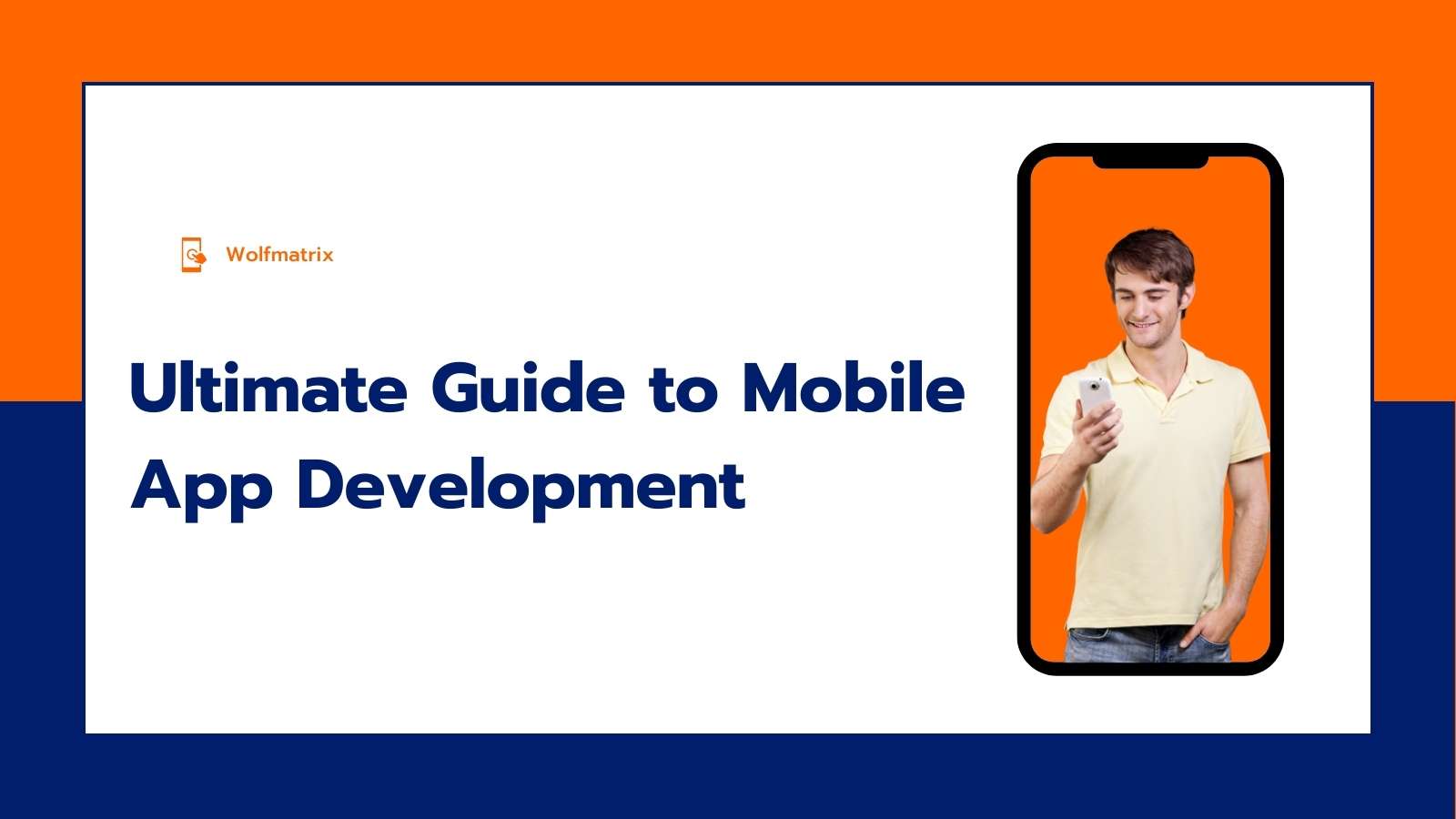As we move into the 21st century, more and more businesses are moving away from traditional storefronts and making a go of them in the app market.
With over two billion active users, there’s a lot of potential for success in this competitive industry. This blog post will begin with an overview of mobile app development, why it is so popular, and all the tit-bit of developing a mobile app from scratch.
What is Mobile App Development?
Mobile app development refers to creating and implementing applications for mobile devices, such as smartphones and tablets. These apps range from simple games to complex business tools with various functions and purposes.
With the rise in smartphone usage over recent years, mobile apps have become an integral part of our daily lives – from checking the weather to online banking and even ordering groceries.
It’s no surprise that businesses are jumping on the mobile app trend to stay relevant and competitive in their industries.
What Is the Importance of Mobile App Development?
For businesses, mobile apps offer a host of benefits. They can provide a convenient way for customers to access your products or services, make purchases, and provide personalized experiences through push notifications and targeted content.
When they develop a mobile application, businesses can gather data on customers’ behavior and preferences, making informed decisions about their marketing and viable product development strategies.
In addition, having a mobile app can enhance a business’s overall branding and visibility, creating a strong presence in the digital world.
As for individuals, mobile apps offer convenience, entertainment, and connectivity to others. They allow us to access information easily, stay organized, and connect with friends and family.
What are the different types of mobile applications?
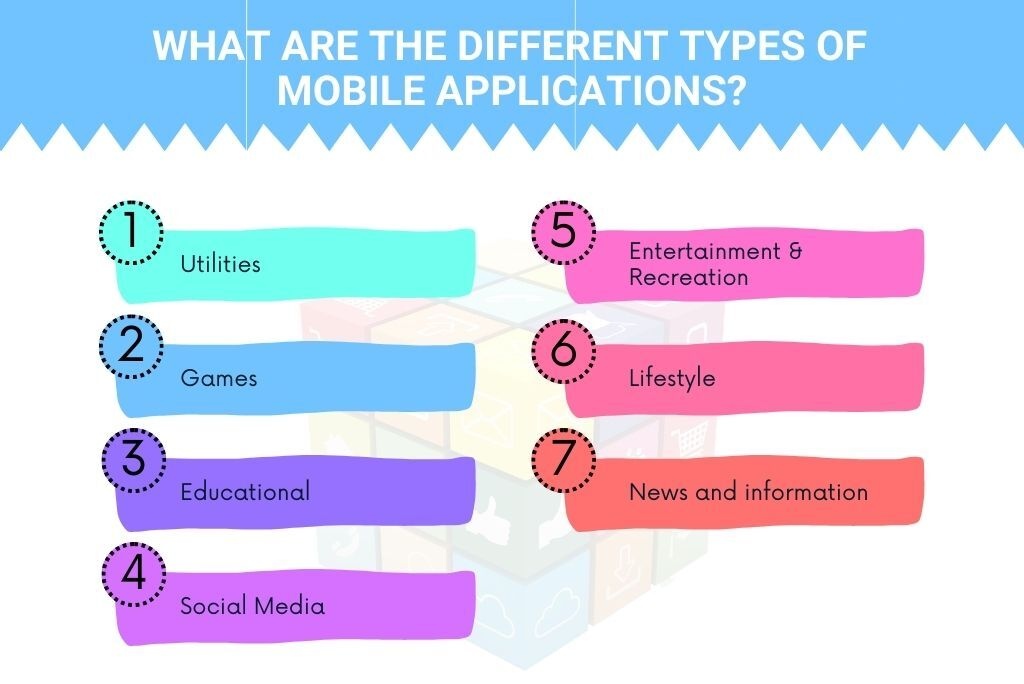
Utilities: These apps serve a practical purpose, such as a calculator or alarm clock.
Games: These are interactive and entertaining apps, often with an addictive quality.
Business: These apps assist with productivity and managing daily tasks for individuals and companies.
Educational: These provide information and learning opportunities, such as language learning or educational games.
Social Media: These apps connect individuals and allow them to communicate and share content.
Entertainment and Recreation: These apps provide a source of entertainment, such as streaming services or virtual reality experiences
Lifestyle: These apps focus on improving the user’s daily life, such as fitness or meditation tracking
News and information: These apps provide updates and news from various sources
Shopping: These apps allow users to browse and purchase products from their devices.
How Do You Make a Mobile App?
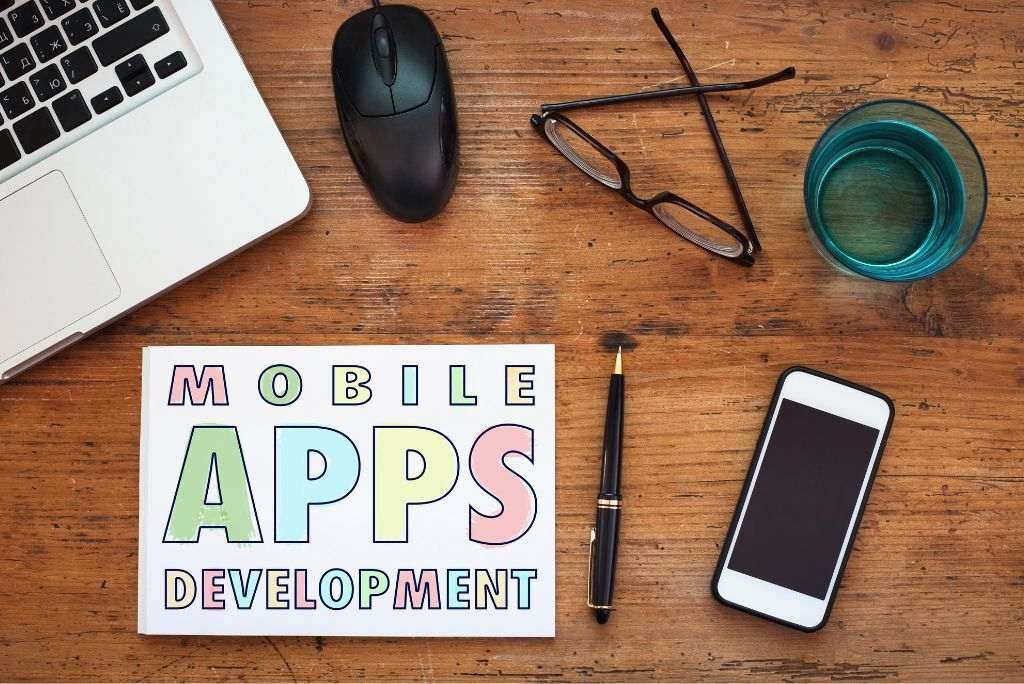
There are several crucial steps to creating a successful mobile app
1) Define the purpose and goals of your app
2) Do market research to identify your target audience and competitors
3) Develop a strategy for monetization, such as through in-app purchases or advertising
4) Design a user interface and user experience that are intuitive and visually appealing
5) Create a prototype to test the functionality of your app
6) Develop and code the app using programming languages such as Java or Swift
7) Test and troubleshoot any issues before launching
8) Market your app through social media, advertisements, and app store optimization
We will discuss this step-by-step process here:
Mobile app development lifecycle
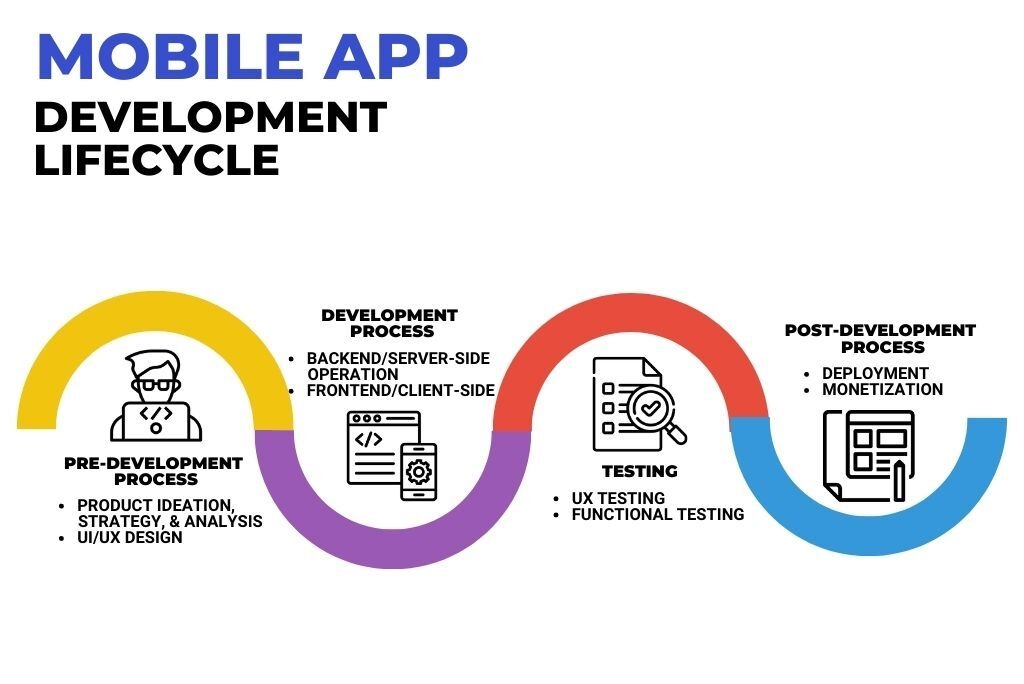
Pre-Development Process
- Product Ideation, Strategy, and analysis
Product Ideation involves defining the goals and purpose of your app, conducting market research, and creating a monetization strategy.
- UI/UX design
It involves designing a user interface and user experience that are visually appealing and intuitive for the user.
Development Process
- Backend/Server-side Operation
It involves setting up the server and database for your app
- Application Program Interface (API)
It allows your app to communicate and exchange data with other apps, websites, or devices.
Frontend/Client-side
- Frontend/Client-side Operation
It involves coding your app’s user interface and functionality using programming languages such as Java or Swift.
Testing
- User experience testing
User experience testing ensures that the app’s design and user interface are easy to navigate.
- Functional testing
Functional testing is done to ensure that all the features and operations of the app are working properly.
- Performance testing
Performance testing identifies and addresses app performance issues like slow load times or crashes.
- Security testing
Security testing ensures that the app is protected against hacks and data breaches.
- Certification testing
Certification testing is required for some app stores, such as Google Play, to ensure the app meets its guidelines and standards.
Post-Development Process
- Deployment
In this process, the app is submitted to app stores and made available for download.
- Monetization
Monetization strategies, such as in-app purchases or advertising, can be implemented at this stage.
- Marketing and promotion
Marketing and promotion involve social media advertising, app store optimization, and influencer marketing.
- Maintenance and Support
It involves troubleshooting issues and releasing updates to improve the app’s performance and add new features.
Elements that affect your mobile app development cost
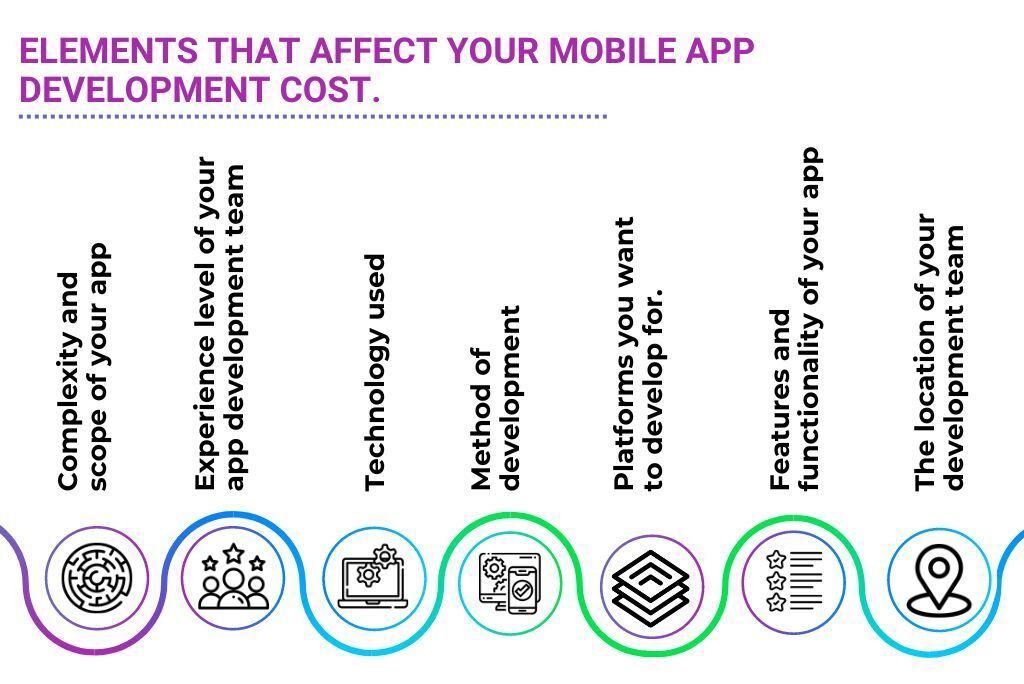
The complexity and scope of your app
The complexity of your app’s features and functions and the number of platforms you want it to be available on can greatly affect the cost of developing mobile applications.
The experience level of your app development team
Hiring a highly experienced mobile app development team will likely result in a higher cost compared to a less experienced team.
The technology used
Using advanced technologies and updating your app to the latest versions can also affect costs.
The method of development
A streamlined, agile development approach can save time and cost compared to a traditional, sequential approach.
The platforms you want to develop for (iOS, Android, both)
Designing for iOS and Android platforms can increase the cost compared to just one platform.
Whether you use a template or custom design
Using a pre-made template can save on cost compared to custom design all aspects of your app.
In-app purchases and integrations Adding in-app purchases or integrating with third-party platforms can also affect the development cost.
Whether you outsource development or have in-house resources
Outsourcing app development to a company or agency will likely cost more than in-house resources.
The location of your development team
Different regions or countries can have varying rates for app development services. However, it can also affect costs if your development team is located in different places.
The timeframe for development
A shorter timeframe may require more resources, resulting in a higher cost. On the other hand, a longer timeframe can allow for better planning and lower costs.
The features and functionality of your app
The more advanced and unique features your app has, the higher the development cost.
Additional services
Optimization for search engines, localization for different languages, or additional marketing and promotion efforts can also affect costs.
The cost of any third-party tools or resources used in the development process
Using paid tools or resources, such as software licenses or stock images, can add to the overall cost.
Overall project management and communication efforts
Strong project management and clear communication can help ensure that development stays on track and within budget. It can also affect costs if additional time is needed for project management or miscommunication results.
Ongoing maintenance and support costs
Keeping up with updates and addressing technical issues can also affect the long-term cost of app development.
To learn more about the cost of mobile development in Australia, click here!
Factors that determine the Efficiency of the Mobile App Development Process
The experience level and expertise of the development team
A team with more experience and expertise in mobile app development will likely have a smoother and more efficient process, as they are familiar with the challenges and nuances of the industry. They may also be able to anticipate potential issues and come up with innovative solutions.
The project management approach
An effective project management approach, such as agile methodologies, can streamline development and improve efficiency. It includes clear communication, setting realistic goals and timelines, and making adjustments during desktop or phone app development.
The technology used
Using well-suited technologies for mobile application development can make the process more efficient. For example, it includes utilizing tools that help streamline the development process, such as integrated development environments (IDEs) and version control systems.
Testing and quality assurance efforts
Conducting thorough testing and quality assurance can ensure that the final product is high-quality and functioning properly, improving efficiency in the long run by reducing the need for fixes and updates.
Collaboration with other teams or stakeholders
Effective collaboration with design, marketing, and other teams can help ensure that the development process aligns with the overall vision for the app. It can also address potential conflicts or issues earlier in the process.
Adaptability
Adapting to changes or unforeseen challenges can help maintain efficiency during development. For example, it may include adjusting timelines or finding alternative solutions.
The agile approach to development
The agile approach focuses on iterative and collaborative development, allowing flexibility and adaptation. In addition, it can improve overall efficiency in the mobile app development process.
Ongoing maintenance and support efforts.
Regular updates and addressing technical issues can maintain the efficiency and functionality of the app in the long term.
The Different Stages Of Mobile App Testing
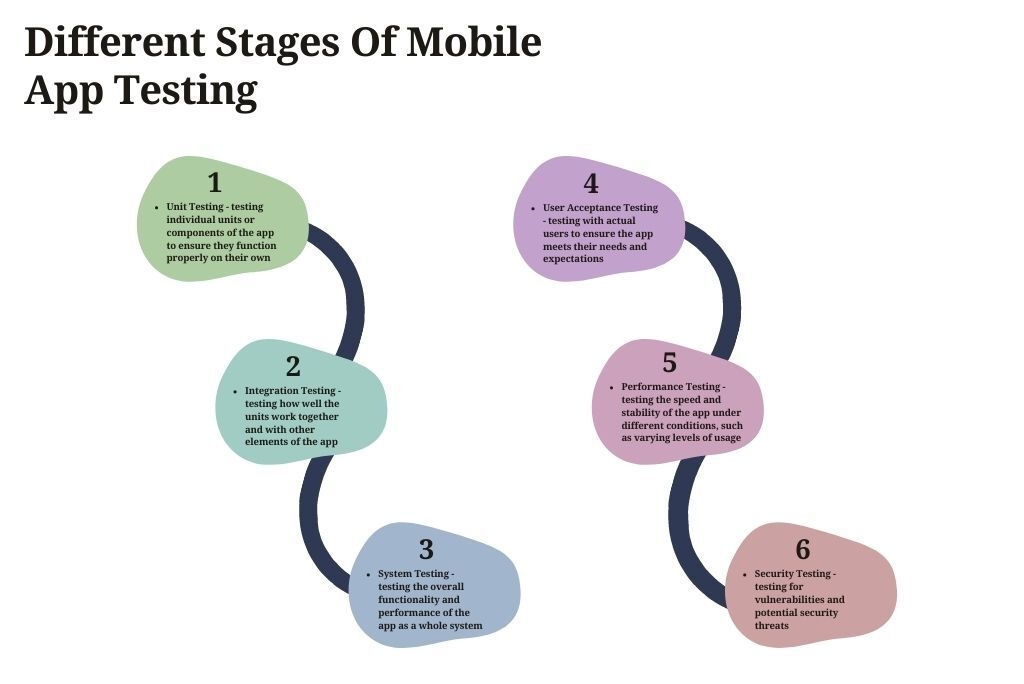
During the mobile app testing, it must go through several tests before the app is ready for release. The app is developed and distributed to testers, who provide
1) Unit Testing – testing individual units or components of the app to ensure they function properly on their own
2) Integration Testing – testing how well the units work together and with other elements of the app
3) System Testing – testing the overall functionality and performance of the app as a whole system
4) User Acceptance Testing – testing with actual users to ensure the app meets their needs and expectations
5) Performance Testing – testing the speed and stability of the app under different conditions, such as varying levels of usage
6) Security Testing – testing for vulnerabilities and potential security threats.
The most common reasons mobile app projects fail
Lack of a clearly defined plan or strategy
The first basic step in creating a successful mobile app is developing a great idea. Once you have an idea, you need to start planning and researching. Then, you need to figure out who your target market is and what it wants. It would be best if you also determined what features your app will have and how it will differ from other apps on the market. Once you have all this information, you can start working on your app’s design and development.
You must take the time to develop a clear plan and strategy for your app to ensure it runs smoothly.
Poor communication between team members and stakeholders
Creating a successful app is essential to communicating clearly and concisely between all team members and stakeholders. Poor communication can lead to misunderstandings and misaligned expectations, ultimately preventing a project from failing.
No market research or knowledge of the target audience
It’s important to do your market research before starting mobile application development. It will help you identify potential competitors and understand what they are doing right or wrong.
Without this information, you may develop an app similar to another already on the market.
Unrealistic timelines and budgets
Setting an unrealistic timeline for a mobile app project is one of the quickest ways to set your team up for failure. If you want your project to succeed, you need to be realistic about how long it will take to complete and how much money you’ll need to invest.
Don’t try to cut corners by skimping on research or development time. Instead, work with your team to create a realistic timeline and budget that you can stick to. You’ll be more likely to deliver a successful product with a realistic plan.
Ignoring user feedback during development
Ignoring user feedback can be just as damaging. Failing to take user feedback into account can result in an app that is difficult to use, lacks important features, or is simply unappealing to its intended users. In the worst-case scenario, ignoring user feedback can cause an app to fail.
Technical issues or lack of proper testing.
Rushing the testing phase to meet deadlines can lead to serious technical issues. Sometimes, these issues are not discovered until after the app has been released, which is too late to fix. As a result, user satisfaction plummets, and the app’s reputation is irreparably damaged.
What Is The Best Way To Submit Your App To The App Store And Google Play Store?
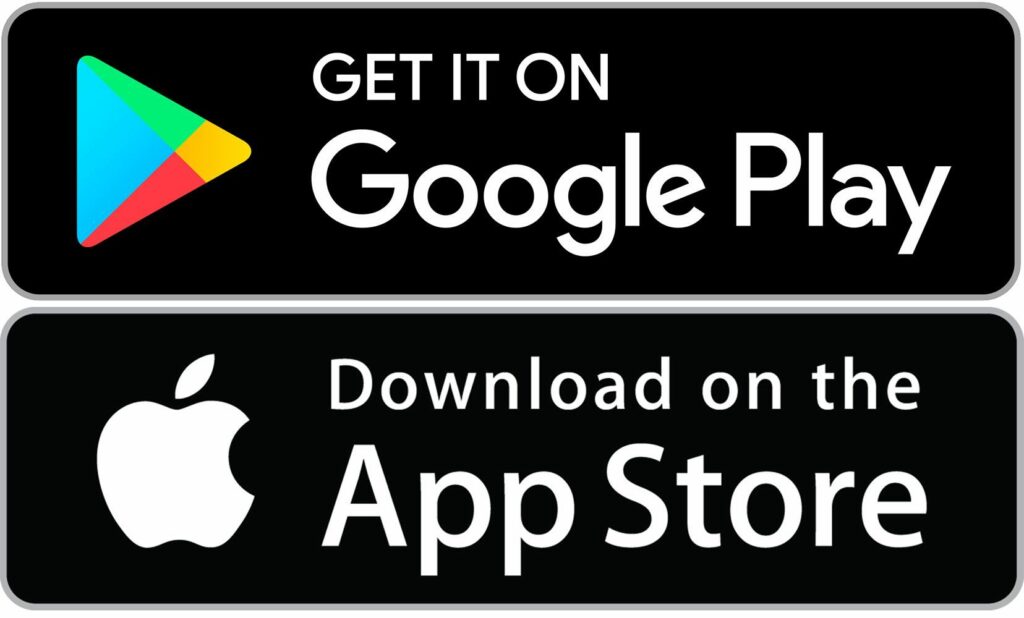
If you built an app and want people to download and use it, you must submit it to the App Store and Google Play Store.
The submission process is different for each store, but there are some similarities.
First, you need to create an account with the store. Then, you’ll need to provide information about your app, including its name, description, category, and contact information. After that, you’ll need to submit screenshots or a video of your app.
Once your app is approved, it will be made available for download. The process can take a few days or weeks, so be patient.
Mistakes to avoid while developing a Mobile App.
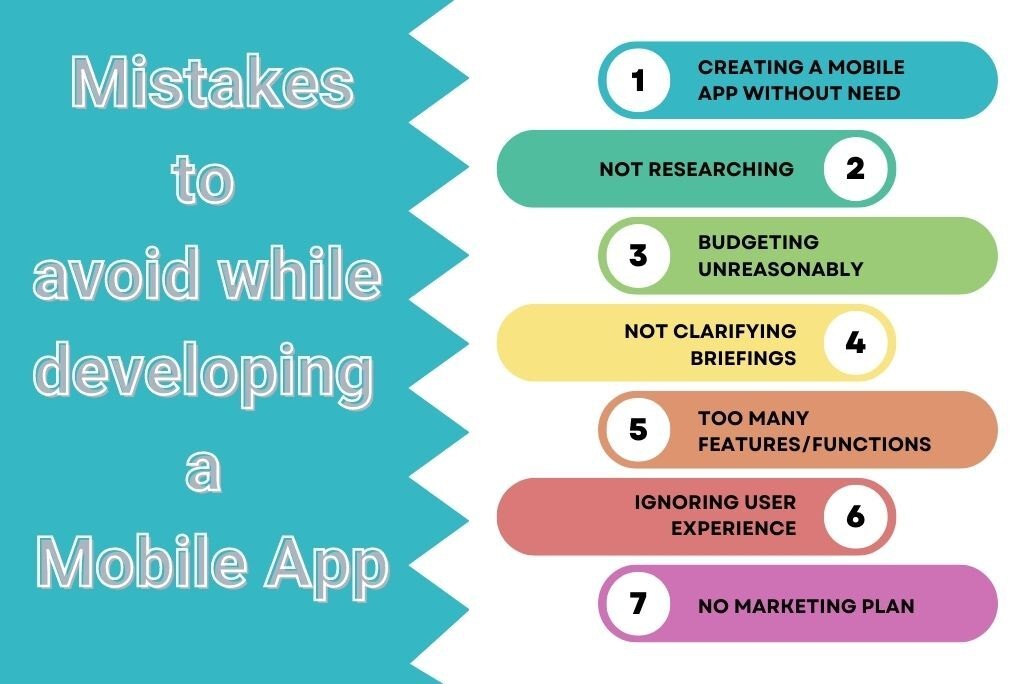
Creating a Mobile App Without Need
Development costs and time make many business owners hesitant to pursue an app for their company. They fear that no one will use it, which would cause their business to suffer. However, apps often have the potential to resolve issues within a company while also meeting consumer expectations.
Before writing off app development, identify company deficiencies and what needs your clients have that still need to be met. For example, it may be worth delving into mobile app development, especially if it could save or even grow your business.
Not Researching
Before development begins on a mobile app, entrepreneurs must take the time to investigate. It will ensure that the goals of the business and the app are aligned from the start. Many factors must be considered, such as target audience, USP, competition, etc. Remember – never conclude Google searches alone! When creating a company mobile app, taking the time to do proper research upfront may save you money.
Budgeting Unreasonably
Before creating a personalized mobile app, you need to factor in the cost of hiring developers, designers, and app marketers. Depending on your desired features and complexity, the development could take weeks or months.
The best way to gauge how much this will all cost is by conducting market research and getting quotes from firms and freelancers. Once you understand the required budget better, you can start discussions with potential developers about your needs and objectives for the app.
Not Clarifying Briefings
The easiest way to prevent miscommunication when outsourcing app development is to provide visuals of what you need. It means creating flowcharts, diagrams, and screen drawings with accompanying explanations of each element.
For example: What happens when users click a button? Which screens appear after certain activities are completed? By doing this, you give developers a clear understanding of the scope of your project so they can set a fair budget that meets your expectations.
Too Many Features/Functions
It’s great to have an app with unique features, but it’s not sensible to expect an app with every function under the sun. Instead, each feature lengthens development time and ups the cost. More complex apps are also more expensive to build, and you can only be sure potential buyers will use some of those bells and whistles anyway.
The smart route is to start with a business app and then add new features or improve existing ones based on customer feedback.
Not Creating a Cross-Platform Strategy
Another problem is needing a good cross-platform strategy. Developers may create Android and iOS apps using new cross-platform app development tools. Cross-platform mobile apps have downsides, but they’re a good alternative for low-budget developers. It will also let you test the market and determine whether to go native or hybrid.
Ignoring User Experience
A great mobile app with a bad UX won’t help. It would be best to focus on consumer needs rather than design when creating an app. User experience engages and improves customers. Make the app design fluid and simple so users can quickly browse screens. Build an app for end-users, not your business.
Apps that meet business needs and provide a great user experience may boost your business.
No Marketing Plan
Before you build an app, take some time to develop a marketing approach. Targeting your app’s right demographic is more important than just building it. With thousands of new apps hitting the market daily, competition is fierce. If you don’t have the plan to market your app, it will get lost in the shuffle and never sell. Instead, you can effectively market your app by researching who your audience is likely to be, optimizing how it appears on store pages, getting user reviews, utilizing social media platforms, and finding key influencers in your field.
How to find the right mobile app development company?
Now that we have covered all the related aspects of the mobile development process, costs and mistakes, you would now have to find the right mobile development company.
Here are some quick tips for you.
1. Look for companies with experience in your industry or a related one
2. Make sure they have a solid portfolio and positive client reviews
3. Discuss your budget, needs, and desired features upfront to ensure they can meet them within that budget
4. Ask about their testing and quality assurance process to ensure the finished product will be bug-free and user-friendly
5. Communicate clearly throughout the development process to communicate effectively and effectively.
Mobile App Development Guide FAQs
Which programming language is best for mobile app development?
There is no “best” language for mobile app development as it depends on the specific requirements and goals of the project. For example, some popular languages for mobile app development include Java, C++, and Objective-C.
How much does it cost to develop a mobile app?
The cost of developing a mobile app can vary greatly depending on the factors mentioned in this comprehensive article, such as the platform(s) being developed for, the complexity and number of features, and the experience level of the development team. For example, a small business app can cost anywhere from $50,000 to $100,000.
What is hybrid mobile app development?
Hybrid app development is creating a mobile app that can run on multiple platforms, such as iOS and Android. It is achieved using technology such as HTML, CSS, and JavaScript to create a single codebase that can adapt to different platforms.
What is native mobile app development?
Native app development involves creating separate versions for each platform, using the specific programming language and software development kit. It can result in better performance and a more seamless user experience, but it also requires separate development and maintenance efforts for each platform.
What is the best mobile app development platform?
There is no “best” platform for mobile app development, as it ultimately depends on a project’s specific needs and goals. Some popular platforms include iOS, Android, and Windows Phone. When choosing a platform, it is important to consider the target audience and their preferred devices. Additionally, some businesses may opt for a hybrid development approach to reach a wider audience.
Is Kotlin better than Flutter?
Kotlin and Flutter have unique strengths and limitations, so it is important to consider them carefully before deciding. Using both languages in conjunction for certain projects is also possible.
How much does it cost to start an app?
The cost of building a mobile app can vary greatly, depending on the project requirements and development approach. In addition to development costs, there may also be expenses for market research, branding, and app store fees. Therefore, it is important to thoroughly plan and budget before beginning the development process for building an app.
What is cross-platform mobile app development?
Cross-platform development of mobile apps involves creating a single app that can run on multiple platforms, such as iOS and Android. It is often achieved using HTML, CSS, and JavaScript technologies, but it can also result in performance and user engagement experience limitations compared to native app development.

Passionate engineer who loves talking about Machine learning and ways to improve Software development practices. CEO and Director of Software Engineering of Wolfmatrix.

